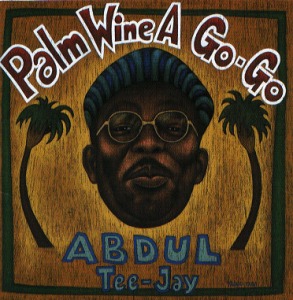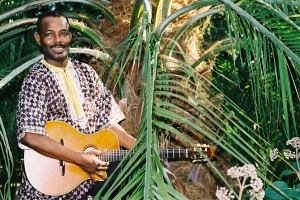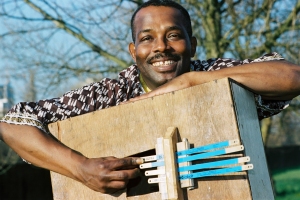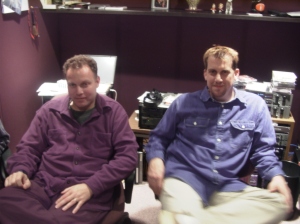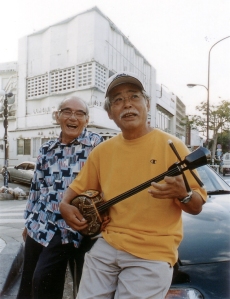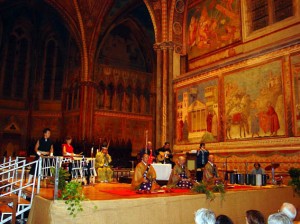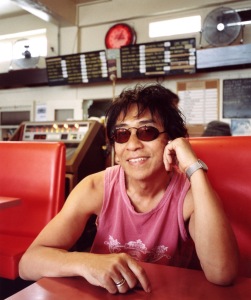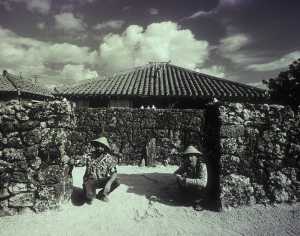Abdul Tee-Jay has been wanting to make this album for many years. He grew up in Freetown, Sierra Leone, listening to the lilting sounds of palm wine guitar. Until now however, he’s never had the chance to record those songs that inspired him to become a musician in the first place. Perhaps it was a good thing he had to wait. ‘Palm Wine a Go-Go’ is a combination of not just those formative years, but other experiences and influences since. Now, those palm wine songs come stamped with Abdul’s own creativity and originality.
Palm wine is the fermented sap juice of the oil palm. A much needed cheap alcoholic drink in a country ravaged by social, economic and political problems. Not surprisingly, when the palm tree is being tapped, and when people drink, they like to sing what became known as palm wine music or locally, maringa. Centered around a single performer on guitar, a couple of listeners add the accompaniment playing on bottles, cigarette tins or palm wine calabashes, struck with a nail or knife blade. The breezy, verse and chorus style sounds somewhat similar to Trinidadian Calypso, and could partly originate with the Caribbean slave immigrants that gave Freetown its name. The two styles might even share a common root in the sailors of Liberia, many of whom were accomplished guitarists plying the West African coast opening up trade and spreading the guitar as they went.
In Abdul’s day the port of Freetown was still a hive of activity. Ghanaians and Congolese, as before armed with guitars, would arrive and mingle with sailors from around the world. The bars were alive with music. Abdul first picked up a guitar when he was nine, the problem being it only had two strings! Abdul persevered, got some new strings and worked out tunings for himself. He picked up tips from the old guys, listened to records and studied music theory out of books. While his friends were into the Beatles, the Rolling Stones and Jimi Hendrix, Abdul liked the unique style of palm wine legend SE Rogie, the local street music, ‘milo jazz’, highlife music from Nigeria and Ghana, Bembeya Jazz from Guinea, and Congolese soukous.
Abdul comes from an academic family, and a career in music was not exactly what they had in mind for him. Nevertheless, from the age of 15 he was sitting in with local bands. The studious side caught up with him, and in 1974 he moved to West Virginia, America to study economics and accounting. He soon started playing music again, and got himself a better guitar. He played jazz funk and even lived and played with the hillbilly musicians of the Appalachian mountains for a while, with whom he found he shared many musical similarities.
In 1979 he moved to London to work in banking, but the urge to play music had never left him. He met some musicians, and at first played reggae, before forming a band, ‘African Connection’ with Ghanaians and other Sierra Leonians. In 1982 he formed ‘African Culture’, the original concept being to play a pan-African music, mixing up influences from just about the entire continent.
People in London would ask Abdul where they could buy Sierra Leonian music, but he never had a good answer. He listened to a tape of traditional street milo jazz, played entirely on drums, and realized that unlike in other African countries, nobody had thought to put those old folk songs to guitar. He decided to write songs based on the old melodies, and develop them into his own style. In 1988, he changed his group’s name to ‘Rakoto’, (the name of an area in Freetown, famous for it’s market, bars and music) with the mission to evolve a modern Sierra Leonian music. At the height of the initial ‘World Music’ boom, Rakoto achieved considerable success with their first album ‘Kanka Kuru’. Abdul Tee-Jay and Rakoto toured the world, playing to packed houses, as they continue to do today. The following ‘Fire Dombolo’ in 1992 is considered by many a classic of modern African dance music, a standard matched by 1997’s ‘E’Go Lef Pan You’.
‘Palm Wine a Go-Go’ is his first full album since then (a retrospective best of Rakoto was released in 2002). During the winter of 2002/3 his songs brought sunshine to a gray winter and a studio in north London. Like palm wine itself, these songs have long been fermenting in the mind of Abdul, maturing, developing, and now very definitely, ready for public consumption.
Paul Fisher
PALM WINE
Palm Wine is a creamy resin tapped from a palm tree by local people throughout West Africa called ‘palm wine tappers’. A calabash gourd is attached at the top of the tree underneath the branches, with a bamboo channel to guide the resin into the gourd. After a few days the palm wine tapper will return and climb the tree to fetch the now full gourd. Because of the fermentation, the palm wine will become alcoholic and is usually drunk at once. Sometimes it is preserved in the gourd for transportation for sale. In terms of alcohol content it is very mild, but gets stronger the more it ferments. Local people will gather and celebrate the tapping with music and song; hence the name palm wine music.
I’ve always wanted to record a non-electric (acoustic) and pure palm wine music, with all the trapping that go with it, even from an early age. With the help of the good people around me, I now present to you, ‘Palm Wine A Go-Go’. Enjoy!
Abdul Tee-Jay.
1. CEE-O LEY-LEY(DAMU ASE-TOKPA) [Kru, Krio & Tenme]
title, (alternative title) [language(s)]
This song is one of the earliest songs to become a palm wine standard in Liberia and Freetown (Sierra Leone). It was first recorded by the “Kru Boys Band” of Freetown. The Kru people hail from Liberia with a very large settlement and great musical heritage in Sierra Leone. The Krios of Sierra Leone and the Krus with the Fanté people of Ghana (both fishermen) are credited with the origin of palm wine guitar music and responsible for introducing the guitar (in it’s Western form) along the West African coast up to the Congo. The pennywhistle, the bottle and the kongoma (bass thumb piano) are regular features in this style of mid-tempo palm wine music as made popular by King Janesco of Sierra Leone. The original song is in a mixture of the Kroo and Bassa languages. Over the years the lyrics have been transformed at the mercy of the musician(s) and everyone, including the palm wine drinker.
“Cee-o Ley Ley, Cee-o Ley Ley, E Lek You Comot Lotto en Mawa You Too Wowor For Mek a Want You oh”.
(yes, you can enjoy and lament about me, but you are too ugly for me to fancy you!).
This is my own version of this wonderfully melodious palm wine standard. Palm wine at it’s best.
2. YOU NOR WAN GIMMIE [Krio & Temne]
A faster style of palm wine guitar playing with emphasis on the first beat of bar one and all four beats of the second bar. It is hard hitting and similar to a variant of an old Sierra Leonean style called ‘Fire Man’ ‘Fire Engine’ or ‘One Way’ with harmonica accompaniment. Also, the ‘nasal’ style of singing is very popular among the Kru musicians.
“Oh ya, Baby, Comot Dey (ya), You Nor Wan Gimmie, You Nor Wan Gimmie Pan You Sweetness, You Meke Mara, Bo Do You Comot Nor Me Hos-oh Baby a Tire Wit you”
(oh please baby, go away. You just tease me and refuse to give me your sweetness. So please get out of my house, I’m tired of you.)
“Tor Konneh Mor pa, or Yayma-yeh Me, Tor Konneh or Lom or t’dayr”
(she can go if she don’t want me, she can go, another one will come to me)
3. A MILLEH TETEH (OH YANDO) [Temne and Llimba]
This song has a two part meaning,
“A Milleh Teteh- Oh Ka me Lotah Ya- Monneh, Oh-yando Oh Ya-yo, A Milleh Teteh – Oh”
(too much envy is not good, it’s just an unnecessary burden on the envier)
” Kereh not Deh Ideh Thay-Thay Ka-a-yay-me, K’lolu-oh”
(I was just sitting down patiently and quietly and I got a little bit of reward for my worries).
With my reward I called out to the palm wine tapper (Lamina Poyo);
“Poyo-poyo Bra Lamina Poyo”
(Lamina, the palm wine tapper, bring me some palm wine.)
Now let’s celebrate “Mampama Timo-yapo Salineh, ka-timo”
(Let’s drink and celebrate with this sweet and delicious palm wine)
The opening rhythms and melodies are typical ‘Taransis’ beats.
4. A NOR NEM YOU [Krio]
Sierra Leone Maringa at it’s best.
“Nar Me Go Nar wan Village, A Reach Dey nar Night. A Meet One Young Lady, e Dress Leke City Gal. As A Wan for Talk to Ram-oh, E Turn im Back Dey Go, Nar-ing A Call Am, A Say “Hey-You”, E Say ‘A Nor-Name You, oh, You Narn wan Yeye Man, A-nor Name You, Bo Call Me By My Name’. How a Go Call You by You Name Wey A Nor Sabi You Wan Day”.
(upon arriving in a village at night, I met a young lady, dressed like a city girl. As I was about to talk to her, she turned her back on me and went on her way. I then shouted to her, ‘Hey You!’, she said ‘my name is not You. You is a one -eyed person (Sierra Leone slang), so please call me by my name’. ‘ How can I call you by your name when I’ve never met you before.’)
5. WÉLÉ KPÉKU [Krio and Slang]
Kpeku is a version of ‘Peku’, a popular and old ‘Krio’ first name in Sierra Leone. To make it more musical I added the other name ‘wéle’. Wélé Kpéku to me sounds like someone having a hard time. I wrote this song for my people in Sierra Leone, who have gone through some very difficult periods recently.
‘Wélé Wata Nor Dey Fordon Nar Wan Man Hos Ya. If we Patient Ya. We Tem Go Cam Nar Sa Lone. If you Ask Me Ya, We Tem Go Cam Nar Sa Lone. Broda (Sista) Do You Patient Mama Sidon Patient Oh We People Patient so-Tay Den Take Trouble (Wahala) Can Put Nar Sa Lone ay Aye Mama, Na God Don Put We Day, Wata Way Na For We-ya. E Nor Go run Pass We Oh Saful- Saful We Go Caytch De Monkey, We Tem Go Can Nar Sa Lone Saful Saful We Go Geh We Diamond..….Keleh Keleh We Go Geh We Sa Lone Back. De Wata Wey Nar For You Ya, E Nor Go Run-Pass you-Oh .
(Rain (prosperity) does not fall down only upon one person’s house. I know that with patience our time will come in Sierra Leone. Brother (Sister) please be patient; sit down and be patient. Our people were patient for so long and some others came and besiege our Sierra Leone with trouble and suffering. Believe in God, the water (river) that is yours will never flow or run beyond your reach. Softly – softly we will catch the mischievous and evil monkey (thieves) Slowly-slowly we will get out diamond and our country back. The river flows past you, but it’s always there for you the rightful owner.)
6. EAST END JORLAY (CORNER CORNER BABY) [Krio and Slang]
I first recorded this collection of popular Jorlay songs in 1982. It was my first ever professional solo acoustic recording. With no formal distribution, nevertheless about 4,000 copies of the E.P. and cassette were sold in the UK and Sierra Leone. ‘Jorlay’ is mainly a boys percussion ensemble with various mask acrobatic dancers (tumblers). Jorlay groups are formed throughout Freetown, with other variations called ‘En Soro’ formed in other parts of Sierra Leone. Most of the Freetown ‘Jorlay’ percussionists, along with “Gumbay” groups usually provide backing music for palm wine guitarists such as Ebenezer Calendar, Ebu, Famous Scrubs, Sammy Kamura, Chris Omotayo-During and The Kru Boys Band, to name a few. As a musical member of the popular Freetown ‘East End Jorlay’, most of the songs are my own compositions. Palm wine meets Jorlay (Jolly). Mmmm.
*The rhythm guitar is with altered tuning.
7. A BUY YOU EVERYTHING [Krio]
The chord progression here is one used mainly by the old masters such as Sammy Kamara, Ebu and Papa Sam. The subject matter as usual is women.
“A Buy You Shimmy, A Buy You Peti-Coat, A Buy You Draws, A Buy You Eberyting. Den A Tell You Say Baby! Cam Go Nar Me Room, Lay-Don Nar Me Sofa, Mek A Ask For Me Labour. Den She Halla Why? Why? Jorlay BoyDey Mona-Me!”
(I bought you a chemise, I bought you a peticoat, I bought you knickers, I bought you everything. Then I said to you baby! ‘let’s go to my room, lie down on my sofa for me to get rewarded for my labour. Then she hullah (shouted) ‘why? why?’ Jorlay boy is troubling me!)
Enjoy the rest, it’s just a raw but harmless music by a palm wine drinker; naturally.
8. MAMPAMA TIMOTEI (SWEET PALM WINE) [Limba]
Like all popular natural products palm wine is known by different names throughout the West African coast. In Sierra Leone alone it’s called by several different names; ‘Mampana’, ‘Poyo’, ‘Timotei’ and ‘From God to Man’ are some examples. ‘Mampana Timotei’ (sweet and delicious palm wine) is the affectionate name given to it by the Limba tribe in Sierra Leone. They and the Loko tribe are the undisputed champions of palm wine tappers.
“Mampama Timo Ya Po Salineh Kati-ay” is always sung to celebrate in the joyful and merry atmosphere during palm wine drinking sessions. The chord sequence and rhythm is a standard known to all popular palm wine guitarists in Sierra Leone and made popular by E. Calender and SE Rogie.
* Inverted 3rds and ‘tipsy’ finger pull offs are used. (see ‘You Go Pay Me’ notes)
9. YOU GO PAY ME [Krio]
‘You Go Pay Me’ (you will pay me) is a composition that for me is one of the ways forward in my progressive and modern music style. One guitar part uses mainly octaves for the melodies, whilst the other part uses ‘inverted thirds’: double note diatonic scale with the third the lowest note eg, C Major;
E/C, F/D, G/E, A/F, B/G, C/A, D/B, E/C
Notice the chord sequences always progressing lower because of the sad nature of the song and accompanied by what I call “palm wine guitar slaps” on the body of the guitar; very rhythmical.
“Nar Waitin Mek U Do Me So, Me Paddy, Nar Waitin a Do U? A’yay A Bo Nar Waitin Mek U Do Me So? A Do For Me Paddy Lilly Favour, Wey Don Turn Big-big Trouble En Wahala Nor nar me Hed Oh. Wen De Tem Cam U Go Pay Me Nar Dis Worl, En Nex Worl U Go Pay Me. Toron-ton ton toron-ton-toron- to Mamie Ay”
(why did you do this to me my friend (seaman) what did I do to you, why, what have I done to you to deserve it? I did my friend a little favour that has now become a big trouble and big burden upon my head. When the time comes you will pay me back, in this world (existence) or next world (after life), you will surely pay me back. I swear (toron-ton) by my mother (and ancestors) we shall meet. )
10. SEE ME NO MORE (WAKA-WAKA BABY) [Krio & Yoruba]
This style of palm wine guitar playing is very popular in Ghana, Nigeria, Liberia and Sierra Leone. It is sometimes called ‘Rekpeteh’- repetition of a one bar chordal and rhythmic riff that entrances the listener. A similar style in Cameroon and Eastern Nigeria is called ‘Ashiko’, with heavy percussion. Again, I’m saying to my sweetheart not to see me anymore.
See me no more, moto cam, you go go; taxi pass, you go go; bicycle pass you go go, poda-poda pass you go go, see me no more baby-ay. Baby sour-ley (x3) baby ashawo. O-yeah Mama, O-yeah, corner- corner baby, waka waka. Me go tell you Mama, a go tell you papa, (all your relatives)
(see me no more, a motor car passes by, you will go; a taxi, a bicycle, public transport passes by; you will go; see me no more. Baby you are too bad. A palm wine drinker maybe, but I know my limits.
11. ODA [krio and featuring kongoma language]
For me, one of the most fascinating and simple instruments of Sierra Leone is the kongoma. Kongoma is a bass thumb piano (I prefer calling it a bass marimba) with three or four prongs. The body is a rectangular wooden box with a round or square hole on top for resonance. On the top end is a bridge slot for the prongs which are hacksaw blades (sometimes bamboo blades). They are tuned in a chordal triad (adding an octave for the 4th pronged version) and plucked with the first and second and/or third fingers of the right hand and the left hand fingers hitting the side of the box. The song is one of the palm wine singer’s usual subject matter; his wife, ‘Oda’.
“Oda, oda yeah, yeah, yeah, na broko sebeh . ‘Pan all the big-mut (mut-mut) nar bonga u cook.Oda yeah yeah yeah na broko sebeh.”
(oda, oda yes, yes, yes, this is bad medicine. Upon all the mouthing off (about your good cooking) it’s fish bones that you cook for me. Oda, oda yes, yes, yes, this is bad medicine. )
“If U want me, U for sabi cook, if U sabi cook a go want you. But U nor for cook for me so, wit gboto-gbata, oda-yeah, yeah, yehi yeah-ay na broko sebeh”
(if you want me you must know how to cook. If you know how to cook, I will want. But please don’t cook for me with rubbish and trash; oda yes, yes, yes it’s bad medicine)
My stomach? You know the parable / saying…
12. PAPA SAM (DIE MAN MARINGA) – [Instrumental]
Instrumental song by one of the all time greats in Sierra Leonean palm wine guitar, the late Papa Sam. Like I explained before the track starts, it’s a tribute to all dead people. The slow tempo denotes respect for our ancestors.
Die Man Maringa (dead people’s meringue)
Oh, watch out for the ghost(s).
13. POLO-LO (MAMBÉNA) [krio and slang]
‘Mambéna” is a very popular Freetown carnival masquerade. During the festive seasons (Christmas, New Year, Easter, end of Ramadam and Pilgrimage (Hadj), the atmosphere in Sierra Leone is beyond words to describe. ‘Polo-lo, polo-lo’ and ‘koyo-koya-koyong’ are just two examples of several Freetown ‘colloquial nonsense’ that are sang during festivities. To call them nonsense is missing the point, because they’re carefully composed and arranged to fit certain melodies and rhythms created by popular instruments.
Mambena kusheh (welcome Mambéna)
The double note scale is diatonic with the root on the bass and the third an octave higher eg. F Major: F/A; G/Bb; A/C, Bb/D, C/E, D/F, E/G, F/A
14. WHO STOLE MY CHICKEN ?[English and Krio]
With palm wine music, you either take the lyrics seriously or have a good laugh with them. Imagine, after a hard day’s work I went home to find one of my chickens missing. Who am I going to ask? The whole world? Armed with my guitar I headed for the market place, drank a lot of palm wine and started singing about my loss. Putting one’s loss and tribulations into a song might get results, instead of ridicule. Anyway, I might have lost a chicken , but I did get a very good song out of the whole saga, and the chicken did come back at the end of the song; ‘koko-ri-o-ko-o!’ Get it?
Dedicated to:
The lates S.E. Rogie (Sierra Leone), Ebeneza Calender (Sierra Leone), Sammy Kamara (Sierra Leone) and Ebua Lotin (Cameroon).
Mwendo (Congo), Koo Nimo (Ghana), A.K. Yeboa (Ghana) and my very dear late friend, Salifu Balla (Sierra Leone). All of them, great “palm wine guitar masters”.
“I will make sure your music lives” – Abdul Tee-Jay
